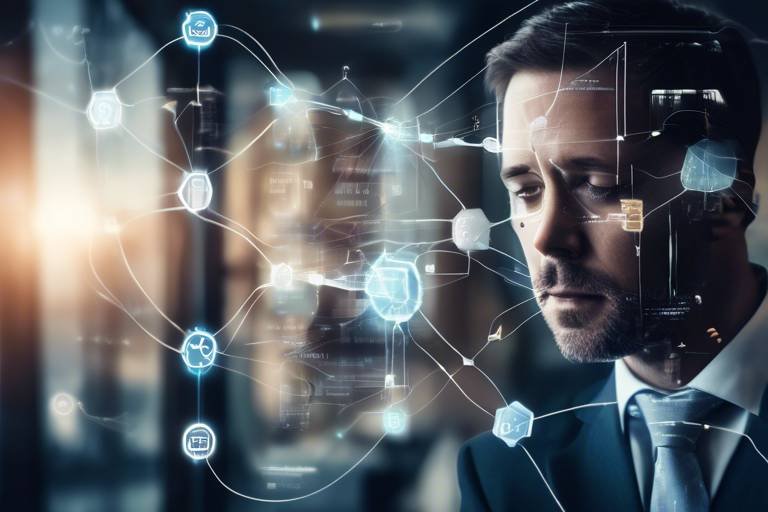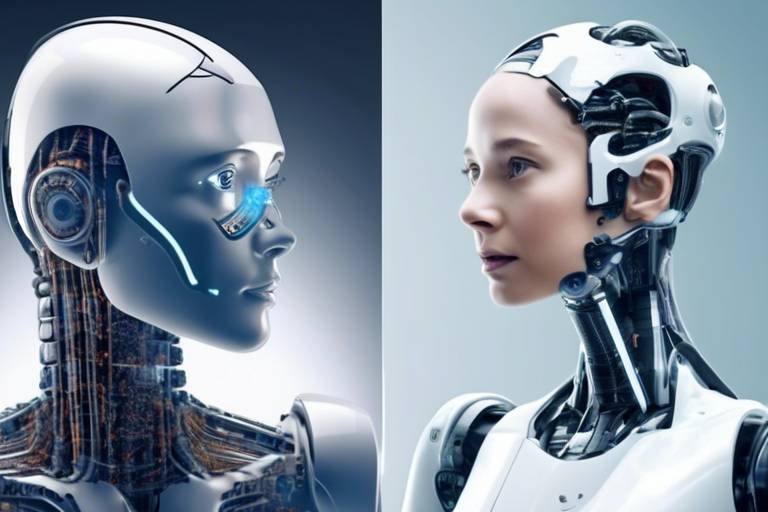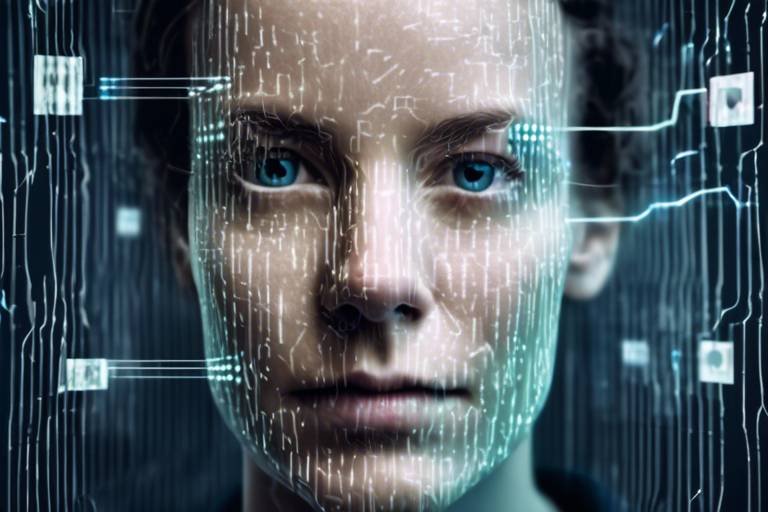Understanding Artificial Intelligence: A Guided Tour
Welcome to the fascinating world of Artificial Intelligence (AI)! This transformative technology is not just a buzzword; it’s reshaping industries, enhancing our daily lives, and pushing the boundaries of what machines can do. From self-driving cars to personal assistants like Siri and Alexa, AI is everywhere, yet many of us still wonder: what exactly is AI? How does it work, and why should we care? In this article, we’ll embark on a guided tour through the fundamental concepts of AI, exploring its applications, challenges, and future prospects. Buckle up, because we’re about to dive deep into a realm that blends science, technology, and a sprinkle of magic!
At its core, AI refers to the simulation of human intelligence in machines that are programmed to think and learn like humans. This includes processes such as problem-solving, learning, and adaptation. The journey of AI began in the mid-20th century, when pioneers like Alan Turing and John McCarthy laid the groundwork for what would become a revolutionary field. Over the years, AI has evolved into various types, including:
- Reactive Machines: These systems can react to specific inputs but have no memory or past experiences to draw from.
- Limited Memory: These AI systems can use past experiences to inform future decisions.
- Theory of Mind: This is a concept that represents a more advanced form of AI that can understand emotions and social interactions.
- Self-Aware: This is the ultimate goal of AI, where machines possess self-awareness and consciousness.
Understanding these classifications helps us appreciate the vast potential of AI and the challenges that come with it. As we explore deeper, we’ll uncover how AI is not just a single entity but a complex ecosystem of technologies and methodologies.
One of the most exciting subsets of AI is Machine Learning (ML). Imagine teaching a child to recognize animals by showing them pictures. Over time, the child learns to identify animals based on the features they observe. Similarly, ML algorithms learn from data to improve their performance in tasks such as decision-making and prediction. This ability to learn from experience is what makes ML so powerful and essential in the AI landscape.
When we talk about machine learning, we often encounter two primary types: Supervised Learning and Unsupervised Learning. Let’s break them down:
- Supervised Learning: This involves training a model on a labeled dataset, where the desired output is known. It’s like having a teacher guiding the learning process. Common applications include spam detection and image classification.
- Unsupervised Learning: In contrast, this method deals with unlabeled data, allowing the model to find patterns and relationships on its own. It’s akin to exploring a new city without a map. Applications include clustering and anomaly detection.
Understanding these distinctions is crucial for grasping how different algorithms can be applied to solve real-world problems.
Supervised learning shines in various industries. For instance, in finance, it can predict stock prices based on historical data. In healthcare, it helps classify diseases from medical images. The effectiveness of supervised learning in tasks like classification and regression makes it a go-to approach for many organizations.
On the other hand, unsupervised learning is invaluable for data exploration. Businesses use it to segment customers based on purchasing behavior, while researchers apply it to discover hidden patterns in large datasets. This ability to uncover insights without predefined labels opens up new avenues for innovation.
As we venture further into AI, we encounter Deep Learning, a specialized form of machine learning that mimics the human brain through Neural Networks. These networks consist of layers of interconnected nodes, processing data in a way that enables them to learn intricate patterns. Deep learning has propelled advancements in fields like computer vision and natural language processing, making it a cornerstone of modern AI applications.
AI is not just an abstract concept; it’s woven into the fabric of our daily lives. From the moment we wake up to the sound of our virtual assistant to the personalized recommendations we receive while shopping online, AI continuously influences our decisions and experiences. It’s like having a personal concierge who knows your preferences and anticipates your needs!
In the realm of healthcare, AI is revolutionizing how we approach diagnostics and treatment. Imagine a world where algorithms analyze medical images with precision, identifying potential health issues earlier than ever before. AI enhances treatment plans by analyzing patient data to suggest personalized interventions, ultimately improving patient care and outcomes.
Businesses are leveraging AI to streamline operations and enhance customer service. Automation of repetitive tasks frees employees to focus on more strategic initiatives, while AI-driven analytics provide insights that inform data-driven decision-making. It’s a game-changer, enabling organizations to operate more efficiently and effectively.
As we embrace the benefits of AI, we must also confront the ethical dilemmas it presents. Issues such as privacy concerns, bias in algorithms, and the future of work demand our attention. It’s crucial to ensure that AI systems are developed responsibly, prioritizing fairness and transparency.
One of the most pressing issues is the potential for bias in AI systems. When algorithms are trained on biased data, they can perpetuate inequalities, leading to unfair outcomes. Developing fair algorithms is not just a technical challenge; it’s a moral imperative that requires collaboration among technologists, ethicists, and policymakers.
Another concern is the impact of AI on employment. While there’s fear of job loss due to automation, it’s essential to recognize that AI also creates new roles and industries. The key lies in adapting to change and upskilling the workforce to thrive in an AI-driven economy.
Q: What is artificial intelligence?
A: AI refers to the simulation of human intelligence processes by machines, especially computer systems.
Q: How does machine learning differ from AI?
A: Machine learning is a subset of AI that enables systems to learn from data and improve their performance over time.
Q: What are some common applications of AI?
A: AI is used in various fields, including healthcare, finance, and customer service, for tasks like diagnostics, fraud detection, and chatbots.
Q: What ethical concerns are associated with AI?
A: Ethical concerns include bias in algorithms, privacy issues, and the potential for job displacement due to automation.

The Basics of AI
Artificial Intelligence, or AI, is a term that often sparks curiosity, excitement, and sometimes confusion. At its core, AI refers to the simulation of human intelligence in machines that are programmed to think and learn like humans. Imagine having a computer that can not only perform tasks but also improve its performance over time based on the data it collects. This is the essence of AI, and it's revolutionizing the way we interact with technology.
To truly grasp the fundamentals of AI, it's important to understand its different types. Generally, AI can be categorized into two main types: Narrow AI and General AI. Narrow AI, which is currently the most common form, is designed to perform specific tasks, such as voice recognition or playing chess. In contrast, General AI, which is still largely theoretical, would possess the ability to understand, learn, and apply knowledge across a wide range of tasks, much like a human being. Think of Narrow AI as a highly skilled assistant, while General AI would be akin to a versatile human colleague.
The historical context of AI is equally fascinating. The journey began in the mid-20th century when pioneers like Alan Turing and John McCarthy laid the groundwork for what would become a booming field. Turing's famous question, "Can machines think?" opened the floodgates for research and exploration. Fast forward to today, and we see AI integrated into various aspects of our lives, from virtual assistants like Siri and Alexa to sophisticated algorithms that power social media feeds.
As we delve deeper into the world of AI, it's essential to recognize its foundational principles. These principles include:
- Learning: The ability of machines to improve their performance based on experience.
- Reasoning: The capacity to solve problems through logical deduction.
- Self-correction: The mechanism by which machines can identify and rectify errors in their processes.
In summary, understanding the basics of AI is not just about grasping technical jargon. It's about appreciating the profound impact it has on our lives and the potential it holds for the future. As we continue to explore AI's capabilities, we must also consider the ethical implications and the responsibilities that come with harnessing such powerful technology.
Q1: What is Artificial Intelligence?
A1: AI is the simulation of human intelligence in machines that are programmed to think and learn like humans.
Q2: What are the types of AI?
A2: The two main types of AI are Narrow AI, which performs specific tasks, and General AI, which would have the ability to understand and learn across multiple tasks.
Q3: How does AI learn?
A3: AI learns through data analysis and algorithms that allow it to improve its performance over time based on experience.

Machine Learning Explained
Machine Learning (ML) is a fascinating subset of artificial intelligence that focuses on the development of algorithms that allow computers to learn from and make predictions based on data. Imagine teaching a child to recognize different animals; you show them pictures, explain the features of each animal, and over time, they learn to identify them independently. That’s essentially how machine learning works, but instead of a child, we’re using sophisticated algorithms and vast amounts of data to train computers. The beauty of ML lies in its ability to improve over time as it processes more information, adapting to new patterns and trends without human intervention.
At its core, machine learning can be categorized into three main types: supervised learning, unsupervised learning, and reinforcement learning. Each type has its unique methodologies and applications that cater to different problems. Supervised learning involves training a model on a labeled dataset, where the algorithm learns to map inputs to the correct output. In contrast, unsupervised learning deals with unlabeled data, seeking to uncover hidden patterns or groupings within the data. Reinforcement learning, on the other hand, is akin to teaching a dog tricks; the model learns to make decisions by receiving rewards or penalties based on its actions.
The significance of machine learning cannot be overstated. It’s everywhere! From personalized recommendations on streaming services to fraud detection in banking, ML plays a crucial role in enhancing user experience and improving operational efficiency. For instance, when you binge-watch a series on Netflix, the platform uses sophisticated algorithms to analyze your viewing habits and suggests shows that align with your interests. This not only keeps you engaged but also boosts Netflix’s user retention.
To understand how machine learning operates, let’s take a closer look at the process involved. Typically, it begins with data collection, where vast amounts of relevant data are gathered. Following this, the data is preprocessed to clean and organize it, making it suitable for analysis. Next, a model is chosen based on the type of learning desired—supervised or unsupervised—and the model is trained on the dataset. During training, the algorithm adjusts its parameters to minimize errors in its predictions. Finally, the model is tested on new data to evaluate its performance and accuracy.
One of the most exciting aspects of machine learning is its ability to evolve. As new data becomes available, the algorithms can be retrained to improve their predictions. This is particularly important in fields like healthcare, where patient data is constantly changing, and accurate predictions can lead to better treatment outcomes. However, while the potential is immense, it’s essential to approach machine learning with caution, as the quality of the data and the design of the algorithms can significantly impact the results.
As we delve deeper into the world of machine learning, it’s crucial to recognize its limitations and challenges. For instance, algorithms can sometimes become biased if they are trained on skewed data. This can lead to unfair outcomes in applications like hiring processes or loan approvals. Thus, ensuring that the data used is diverse and representative is vital for creating fair and effective machine learning models.
In summary, machine learning is a powerful tool that is reshaping industries and enhancing everyday experiences. Its ability to learn from data and improve over time makes it an invaluable asset in our increasingly digital world. As we continue to explore its capabilities, we must also remain vigilant about the ethical implications and strive for fairness in algorithmic decision-making.

Supervised vs. Unsupervised Learning
When diving into the world of machine learning, you’ll quickly encounter two fundamental approaches: supervised learning and unsupervised learning. These two techniques are like the yin and yang of the AI universe, each playing a crucial role in how algorithms learn and make predictions. But what exactly sets them apart? Let’s break it down.
Supervised learning is akin to having a personal tutor guiding you through a subject. In this approach, the algorithm is trained on a labeled dataset, which means that each training example is paired with an output label. For instance, if we were teaching a model to recognize images of cats and dogs, we would provide it with numerous images (the input) along with their corresponding labels (the output). The goal here is straightforward: the model learns to map inputs to the correct outputs based on the examples provided. This method is widely used in applications such as email filtering, where the algorithm learns to classify emails as spam or not spam based on past labeled data.
On the flip side, unsupervised learning is like exploring a new city without a map. In this scenario, the algorithm is given data without any explicit labels or categories. The objective is to identify patterns or groupings within the data on its own. For example, if we provided the same algorithm with a collection of images but without any labels, it might group similar images together based on visual features. This approach is particularly useful in scenarios like customer segmentation in marketing, where businesses want to understand different customer profiles without predefined categories.
To illustrate the differences more clearly, let’s take a look at the following table:
| Feature | Supervised Learning | Unsupervised Learning |
|---|---|---|
| Data Type | Labeled data | Unlabeled data |
| Goal | Predict outcomes based on input data | Discover patterns and groupings in data |
| Common Algorithms | Linear regression, decision trees, support vector machines | K-means clustering, hierarchical clustering, association rules |
| Applications | Spam detection, image classification, medical diagnosis | Market segmentation, anomaly detection, data compression |
Both supervised and unsupervised learning have their unique strengths and use cases. Supervised learning excels in situations where historical data is available, allowing for accurate predictions. In contrast, unsupervised learning shines in exploratory data analysis, helping to uncover hidden patterns that might not be immediately apparent. Understanding these distinctions is vital for anyone looking to harness the power of AI effectively.
In conclusion, while supervised learning is all about learning from examples, unsupervised learning is about discovering the unknown. Both techniques are essential in the toolkit of data scientists and AI practitioners, each contributing to the ever-evolving landscape of artificial intelligence.
- What is supervised learning? Supervised learning is a type of machine learning where an algorithm is trained on labeled data to predict outcomes based on input data.
- What is unsupervised learning? Unsupervised learning involves training an algorithm on unlabeled data, allowing it to identify patterns and groupings independently.
- Can you give examples of supervised learning? Common examples include spam detection in emails, image recognition, and medical diagnosis.
- What are some applications of unsupervised learning? Unsupervised learning is often used in market segmentation, anomaly detection, and data compression.

Applications of Supervised Learning
Supervised learning is a powerful subset of artificial intelligence that has found its way into numerous industries, transforming the way we analyze data and make decisions. At its core, supervised learning involves training algorithms on labeled datasets, where the input data is paired with the correct output. This method allows the algorithms to learn from the data and make predictions or classifications based on new, unseen data. The applications of supervised learning are both vast and varied, showcasing its effectiveness in solving real-world problems.
One of the most prominent applications of supervised learning is in the field of healthcare. Here, algorithms can be trained to predict patient outcomes, diagnose diseases, and even suggest treatment plans. For instance, machine learning models can analyze medical images to detect anomalies such as tumors or fractures, often with a level of accuracy that rivals human specialists. This not only speeds up the diagnostic process but also enhances patient care by enabling early intervention.
In the realm of finance, supervised learning plays a critical role in fraud detection. Financial institutions utilize algorithms to analyze transaction patterns and identify potentially fraudulent activities. By training models on historical transaction data, banks can flag suspicious transactions in real-time, thereby protecting both their assets and their customers. The ability to quickly adapt to new trends in fraudulent behavior makes supervised learning an invaluable tool in the fight against financial crime.
Another exciting application is in marketing. Companies leverage supervised learning to analyze consumer behavior and preferences, allowing for highly targeted advertising campaigns. By predicting which products a customer is likely to purchase based on their past behaviors, businesses can personalize their marketing strategies, ultimately increasing conversion rates. This data-driven approach not only enhances customer satisfaction but also boosts sales and profitability.
Moreover, supervised learning is instrumental in the automotive industry, particularly in the development of self-driving cars. These vehicles rely on vast amounts of labeled data to learn how to navigate various environments. By training on data that includes images of road signs, pedestrians, and other vehicles, machine learning models can make informed decisions in real-time, ensuring safety and efficiency on the roads.
To illustrate the diverse applications of supervised learning, here’s a summary table:
| Industry | Application | Benefits |
|---|---|---|
| Healthcare | Disease diagnosis and patient outcome prediction | Improved accuracy and early intervention |
| Finance | Fraud detection | Real-time protection against financial crime |
| Marketing | Targeted advertising | Increased conversion rates and customer satisfaction |
| Automotive | Self-driving car technology | Enhanced safety and navigation efficiency |
In conclusion, the applications of supervised learning are not only numerous but also essential in driving innovation across various sectors. By harnessing the power of labeled data, industries can make informed decisions, improve efficiency, and ultimately enhance the user experience. As we continue to explore and expand the capabilities of supervised learning, the potential for future applications seems limitless.
- What is supervised learning? Supervised learning is a type of machine learning where algorithms are trained on labeled datasets to make predictions or classifications based on new data.
- How does supervised learning differ from unsupervised learning? Unlike supervised learning, unsupervised learning deals with unlabeled data, focusing on finding patterns and groupings within the data without predefined outputs.
- What are some common algorithms used in supervised learning? Common algorithms include linear regression, logistic regression, decision trees, and support vector machines.
- Can supervised learning be used for real-time applications? Yes, supervised learning can be effectively used in real-time applications such as fraud detection and recommendation systems.

Applications of Unsupervised Learning
Unsupervised learning is like a treasure hunt where the algorithm is the explorer, sifting through vast amounts of data to uncover hidden patterns and insights without any prior guidance. This fascinating branch of machine learning has numerous applications across various domains, proving to be a game-changer in how we analyze and interpret data. One of its most significant applications is in clustering, where data points are grouped based on similarities. For instance, in marketing, businesses can segment their customers into distinct groups based on purchasing behavior, allowing for more targeted advertising strategies.
Another exciting application is in anomaly detection. Here, unsupervised learning algorithms can identify unusual patterns that deviate from the norm, which is particularly useful in fraud detection in finance. Imagine a bank using these algorithms to spot irregular transactions that could indicate fraudulent activity, thereby protecting both the institution and its customers. Similarly, in cybersecurity, unsupervised learning helps in identifying potential threats by flagging unusual network activities.
Data exploration is yet another area where unsupervised learning shines. By analyzing large datasets, these algorithms can help researchers and analysts discover trends and patterns that were previously unnoticed. For example, in healthcare, unsupervised learning can be employed to identify patient subgroups based on symptoms or treatment responses, leading to more personalized medicine approaches.
In addition, unsupervised learning plays a crucial role in recommendation systems. Streaming services like Netflix and Spotify use these algorithms to analyze user preferences and behaviors, allowing them to suggest content that aligns with individual tastes. This not only enhances user experience but also encourages engagement and loyalty to the platform.
To summarize, the applications of unsupervised learning are vast and varied, making it an invaluable tool in today's data-driven world. Below is a brief overview of some key applications:
| Application Area | Description |
|---|---|
| Clustering | Grouping data points based on similarities for targeted marketing and customer segmentation. |
| Anomaly Detection | Identifying unusual patterns in data for fraud detection and cybersecurity. |
| Data Exploration | Discovering trends and insights in large datasets for research and analysis. |
| Recommendation Systems | Suggesting content based on user preferences to enhance engagement. |
As we continue to harness the power of unsupervised learning, the potential for innovation and efficiency across various sectors is boundless. It's an exciting time to be involved in the world of AI, where the algorithms are not just learning from the data but are also shaping how we understand and interact with the world around us.
- What is unsupervised learning? Unsupervised learning is a type of machine learning where algorithms analyze and interpret data without labeled outcomes, allowing them to identify patterns and relationships within the data.
- How does unsupervised learning differ from supervised learning? Unlike supervised learning, which requires labeled data for training, unsupervised learning works with unlabeled data, making it ideal for discovering hidden structures.
- What are some common algorithms used in unsupervised learning? Common algorithms include K-means clustering, hierarchical clustering, and principal component analysis (PCA).
- Can unsupervised learning be used for real-time applications? Yes, unsupervised learning can be applied in real-time scenarios, such as fraud detection and dynamic recommendation systems, to adapt to new data as it comes in.

Deep Learning and Neural Networks
Deep learning is a fascinating subset of artificial intelligence that has gained immense popularity over the past decade. At its core, deep learning mimics the way humans learn, utilizing a structure known as neural networks. Imagine a web of interconnected neurons in the human brain; that's essentially what deep learning does with data. It processes information in layers, allowing machines to recognize patterns, make decisions, and even generate new content. This methodology is akin to peeling an onion, where each layer reveals more about the data, leading to deeper insights and understanding.
Neural networks are composed of layers of nodes, or "neurons," where each neuron receives input, processes it, and passes it on to the next layer. The architecture typically consists of three main types of layers:
- Input Layer: This is where the data enters the network. Each neuron in this layer represents a feature of the data.
- Hidden Layers: These layers perform various transformations on the inputs. The deeper the network (more hidden layers), the more complex features it can learn.
- Output Layer: This layer produces the final output, whether it's a classification, a prediction, or some other result.
One of the most remarkable aspects of deep learning is its ability to learn from vast amounts of unstructured data, such as images, audio, and text. For instance, convolutional neural networks (CNNs) are particularly effective for image recognition tasks. They can identify objects in pictures with astonishing accuracy, which is why they're used in applications ranging from facial recognition to autonomous vehicles. On the other hand, recurrent neural networks (RNNs) excel in processing sequential data, making them ideal for tasks like natural language processing and time-series analysis.
As we delve deeper into the world of deep learning, it’s essential to recognize its transformative potential across various industries. For example, in healthcare, deep learning algorithms can analyze medical images to detect diseases at an earlier stage than traditional methods. In finance, these algorithms can predict stock market trends by analyzing historical data patterns. The possibilities are virtually endless, and as technology advances, the capabilities of deep learning will continue to expand.
However, it’s important to approach deep learning with caution. As with any powerful tool, there are challenges and ethical considerations to address. The complexity of neural networks can lead to a lack of transparency, often referred to as the "black box" problem. This means that while the algorithms can produce highly accurate results, understanding how they arrived at those conclusions can be difficult. Additionally, the reliance on large datasets raises concerns about data privacy and security.
In conclusion, deep learning and neural networks represent a significant leap forward in artificial intelligence. They are not just buzzwords; they are reshaping our world in profound ways. As we continue to explore this technology, it is crucial to balance innovation with ethical considerations, ensuring that the benefits of deep learning are accessible to all while minimizing potential risks.
What is deep learning? Deep learning is a subset of artificial intelligence that uses neural networks with many layers to analyze various forms of data and make predictions.
How do neural networks work? Neural networks consist of layers of interconnected nodes that process input data, transforming it through hidden layers before producing an output.
What are the applications of deep learning? Deep learning is used in various fields, including healthcare for disease detection, finance for market predictions, and even in self-driving cars for object recognition.
What are the challenges of deep learning? Some challenges include the "black box" problem, which makes it hard to interpret how decisions are made, and concerns about data privacy and the need for large datasets.

AI in Everyday Life
Artificial Intelligence is not just a buzzword; it’s a part of our daily lives, often in ways we don’t even realize. From the moment you wake up to the sound of your smart alarm clock to the time you unwind by binge-watching your favorite series recommended by an algorithm, AI is seamlessly integrated into your routine. It’s like having an invisible assistant that knows your preferences and helps you navigate through the complexities of modern life.
One of the most noticeable ways AI impacts our everyday lives is through virtual assistants. Think about Siri, Alexa, or Google Assistant. These digital helpers can manage your calendar, control your smart home devices, and even provide you with the latest news updates—all through simple voice commands. It’s almost like having a personal concierge at your beck and call, ready to help you juggle your tasks. But how do they work? These assistants utilize natural language processing (NLP) and machine learning algorithms to understand your requests and improve their responses over time. It’s a fascinating blend of technology that makes life not just easier but also more enjoyable.
Furthermore, AI plays a crucial role in the recommendation systems we encounter on platforms like Netflix, Spotify, and Amazon. Have you ever wondered how Netflix seems to know exactly what you want to watch next? It’s all thanks to AI algorithms that analyze your viewing habits and those of millions of other users to suggest content tailored specifically for you. This personalization enhances your experience, making it feel like the platform truly understands your tastes. In essence, AI transforms our viewing and shopping experiences into something more engaging and relevant.
Moreover, AI is making waves in the realm of healthcare, significantly improving patient care and diagnostics. Imagine a world where your doctor can predict potential health issues before they even arise. AI algorithms can analyze vast amounts of medical data, identifying patterns that human eyes might miss. This capability is not just revolutionary; it’s life-saving. For instance, AI can help in early detection of diseases like cancer by analyzing medical images with remarkable accuracy. It’s a powerful tool that complements the expertise of healthcare professionals, leading to better outcomes for patients.
In the business sector, AI is reshaping how companies operate and engage with customers. Businesses harness AI for automation, enhancing efficiency by streamlining repetitive tasks that would otherwise consume valuable time. For example, chatbots powered by AI are becoming increasingly common in customer service. They can handle inquiries, provide support, and even process orders, all while learning from interactions to improve their responses. This not only saves time but also enhances customer satisfaction, as clients receive quick and accurate assistance. It’s a win-win situation, driving productivity while keeping customers happy.
As we continue to integrate AI into our lives, it’s essential to acknowledge its profound impact on various sectors. The technology is not just a tool; it’s a partner that helps us make better decisions, enhances our experiences, and even improves our health. However, it’s vital to stay informed about the implications and ethical considerations that come with such advancements. After all, as we embrace this technology, we must ensure it serves humanity’s best interests.
- What is AI? AI, or Artificial Intelligence, refers to the simulation of human intelligence in machines that are programmed to think and learn like humans.
- How does AI affect our daily lives? AI impacts our daily lives through virtual assistants, recommendation systems, healthcare innovations, and business automation.
- Is AI safe to use? While AI can enhance efficiency and convenience, it’s important to consider ethical implications, such as privacy and bias in algorithms.
- Will AI replace jobs? AI may automate certain tasks, but it also creates new job opportunities and industries, requiring a shift in skills and roles.

Healthcare Innovations
Artificial intelligence is not just a buzzword; it’s a transformative force in the healthcare sector. Imagine a world where doctors can diagnose diseases with the precision of a hawk spotting its prey, all thanks to AI. This technology is revolutionizing healthcare in ways that were once considered the realm of science fiction. From predictive analytics to personalized medicine, AI is reshaping how we approach health and wellness.
One of the most exciting innovations powered by AI is its ability to analyze massive datasets to identify patterns that humans might miss. For instance, AI algorithms can sift through thousands of medical records in seconds, pinpointing trends in patient outcomes and suggesting optimal treatment plans. This capability not only enhances the accuracy of diagnoses but also significantly reduces the time it takes to develop effective treatment strategies.
Moreover, AI-driven tools are being developed to assist medical professionals in real-time during surgeries. Imagine a surgical robot that can analyze a patient’s vitals and suggest adjustments during a procedure. This level of precision can lead to fewer complications and faster recovery times. It’s like having a co-pilot who is always ready to provide insights and suggestions based on vast amounts of data.
Another area where AI is making a significant impact is in medical imaging. Traditional imaging techniques, such as X-rays and MRIs, require expert interpretation, which can sometimes lead to human error. AI algorithms are being trained to interpret these images with remarkable accuracy, often outperforming human radiologists. For example, studies have shown that AI can detect conditions like pneumonia or tumors in imaging scans faster and with greater accuracy.
Additionally, AI is paving the way for personalized medicine. By analyzing genetic information, AI can help tailor treatments to individual patients, ensuring that they receive the most effective therapies based on their unique genetic makeup. This approach not only improves patient outcomes but also minimizes the risk of adverse reactions to medications.
However, with great power comes great responsibility. The integration of AI into healthcare raises questions about data privacy and security. Patient data is incredibly sensitive, and ensuring that this information is protected while still allowing for AI analysis is a critical challenge that the industry must address. As we continue to explore the potential of AI in healthcare, it’s essential to balance innovation with ethical considerations.
In summary, the innovations brought about by AI in healthcare are not just enhancing existing practices; they are fundamentally changing the landscape of medical care. From improving diagnostic accuracy to enabling personalized treatments, AI is setting the stage for a healthier future. As we embrace these advancements, we must also remain vigilant about the ethical implications and strive to create a healthcare system that benefits everyone.
- How is AI used in healthcare? AI is used in healthcare for diagnostics, treatment recommendations, patient monitoring, and even robotic surgeries.
- What are the benefits of AI in healthcare? The benefits include improved accuracy in diagnoses, personalized treatment plans, enhanced patient care, and efficiency in administrative tasks.
- Are there any risks associated with AI in healthcare? Yes, risks include data privacy concerns, potential biases in algorithms, and the need for regulatory oversight to ensure safety and efficacy.

AI in Business
Artificial Intelligence is not just a buzzword; it’s a **game-changer** that’s reshaping the business landscape in ways we never imagined. From small startups to Fortune 500 companies, AI is being harnessed to streamline operations, enhance customer experiences, and drive innovation. Have you ever wondered how companies manage to personalize your shopping experience or predict what you might want next? That’s AI at work, and it’s making businesses smarter and more efficient every day.
One of the most significant impacts of AI in business is its ability to analyze vast amounts of data quickly and accurately. Traditional methods of data analysis can be time-consuming and prone to human error. However, AI algorithms can sift through mountains of data in seconds, uncovering trends and insights that would take humans ages to discover. This capability allows businesses to make **data-driven decisions** that can lead to increased profitability and a competitive edge in the market.
Moreover, AI is revolutionizing customer service. Chatbots powered by AI can handle inquiries 24/7, providing instant responses to customer queries. This not only enhances customer satisfaction but also frees up human agents to tackle more complex issues. Imagine a scenario where a customer has a question at midnight; with AI, they don’t have to wait until morning for assistance. This level of responsiveness can significantly improve customer loyalty and retention.
Additionally, AI is playing a crucial role in automating repetitive tasks. For instance, in industries like manufacturing, AI-driven robots can perform routine tasks with precision, reducing the risk of errors and increasing productivity. This automation allows human workers to focus on more strategic tasks that require creativity and critical thinking. The synergy between human intelligence and artificial intelligence is paving the way for more innovative business practices.
To illustrate the diverse applications of AI in business, consider the following table:
| Application | Description | Benefits |
|---|---|---|
| Customer Service | AI chatbots and virtual assistants | 24/7 support, improved response times |
| Data Analysis | Predictive analytics and trend analysis | Informed decision-making, identifying opportunities |
| Marketing | Personalized recommendations and targeted ads | Increased engagement, higher conversion rates |
| Supply Chain Management | Optimizing logistics and inventory | Cost reduction, improved efficiency |
As AI technology continues to evolve, its applications in business are expected to expand even further. Companies are investing heavily in AI research and development, recognizing that those who adopt these technologies early will likely lead their industries. However, the integration of AI also brings challenges, such as the need for skilled personnel to manage and interpret AI systems effectively.
In conclusion, AI is not just a tool; it’s a **transformative force** that is driving the future of business. By embracing AI, companies can enhance their operations, improve customer experiences, and ultimately achieve greater success. As we move forward, it’s essential for businesses to stay informed about AI advancements and consider how they can leverage this technology to stay ahead of the curve.
- What is AI in business? AI in business refers to the use of artificial intelligence technologies to improve operations, enhance customer experiences, and drive innovation.
- How can AI improve customer service? AI can automate responses to customer inquiries through chatbots, providing instant support and freeing up human agents for more complex issues.
- What are the benefits of using AI for data analysis? AI can analyze large datasets quickly, uncovering insights that inform decision-making and help identify new business opportunities.
- Will AI replace human jobs? While AI may automate certain tasks, it also creates new job opportunities and allows human workers to focus on more strategic roles.

The Ethical Considerations of AI
As we dive deeper into the world of artificial intelligence, it becomes increasingly important to reflect on the ethical considerations that accompany this powerful technology. AI has the potential to transform our lives in remarkable ways, but with great power comes great responsibility. It's akin to having a superpower; if not used wisely, it can lead to unintended consequences. One of the most pressing concerns revolves around privacy. With AI systems constantly collecting and analyzing data, the question arises: how much of our personal information are we willing to sacrifice for convenience?
Moreover, the issue of bias in AI algorithms cannot be overlooked. These systems learn from historical data, and if that data is flawed or biased, the AI can perpetuate and even amplify these inequalities. This raises critical questions about fairness and justice. For instance, if an AI system is used in hiring processes, it could inadvertently discriminate against certain groups if the training data reflects societal biases. The challenge lies in ensuring that AI systems are trained on diverse and representative datasets to minimize such risks.
Another ethical dilemma revolves around the future of work. As AI continues to evolve, there are legitimate concerns about job displacement. Many fear that automation will lead to widespread unemployment, particularly in industries that rely heavily on routine tasks. However, it's essential to consider the flip side: AI also creates new job opportunities and industries. The key is to strike a balance between embracing innovation while also preparing the workforce for a changing landscape.
To address these ethical challenges, several organizations and governments are working on frameworks and guidelines that promote responsible AI development. These frameworks often emphasize transparency, accountability, and the need for ongoing human oversight. For instance, many advocate for the inclusion of diverse teams in AI development to ensure that different perspectives are considered, ultimately leading to more equitable outcomes.
In summary, while AI holds immense promise, we must approach its development and deployment with a critical eye. The ethical considerations surrounding AI are complex and multifaceted, requiring collaboration among technologists, ethicists, policymakers, and the public. It's a collective responsibility to navigate these challenges and ensure that the future of AI is not only innovative but also ethical and inclusive.
- What are the main ethical concerns related to AI? The primary concerns include privacy, bias, job displacement, and the need for transparency in AI systems.
- How can bias in AI be mitigated? Bias can be reduced by using diverse datasets for training and involving multidisciplinary teams in the development process.
- Will AI lead to job loss? While AI may displace some jobs, it also creates new opportunities and industries; the focus should be on reskilling the workforce.
- What role do governments play in AI ethics? Governments are increasingly developing regulations and guidelines to ensure responsible AI use and protect citizens' rights.

Bias and Fairness in AI
Artificial Intelligence (AI) is revolutionizing the way we live and work, but with great power comes great responsibility. One of the most pressing issues in the field of AI today is the challenge of bias and fairness. As AI systems increasingly make decisions that affect our lives—from hiring practices to loan approvals—it's essential to understand how bias can creep into these systems and what it means for fairness.
Bias in AI can originate from various sources, including the data used to train algorithms and the design choices made by developers. For instance, if an AI system is trained on historical data that reflects past prejudices, it may inadvertently learn and perpetuate those biases. This is particularly concerning in sensitive areas such as criminal justice, where biased algorithms can lead to unfair sentencing or policing practices.
To illustrate the impact of bias, consider the following examples:
- Hiring Algorithms: If a hiring algorithm is trained on data from a company that has historically favored one demographic over others, it may favor candidates from that demographic, thereby perpetuating inequality.
- Facial Recognition: Studies have shown that facial recognition systems often misidentify individuals from minority groups, leading to potential wrongful accusations or discrimination.
Addressing bias is not just a technical challenge; it's also a moral imperative. The development of fair algorithms requires a multi-faceted approach, including:
- Diverse Data Sets: Ensuring that the data used for training AI systems is representative of all demographics can help mitigate bias.
- Regular Audits: Conducting audits of AI systems to identify and rectify biased outcomes is crucial for maintaining fairness.
- Inclusive Design Teams: Involving a diverse group of people in the development process can lead to more equitable AI systems.
Moreover, the conversation around bias and fairness in AI is evolving. Organizations and researchers are increasingly aware of the need for transparency and accountability in AI systems. Initiatives like the AI Ethics Guidelines developed by various tech companies and governments aim to establish standards for ethical AI development. These guidelines emphasize the importance of fairness, accountability, and transparency, urging developers to actively work against bias.
In conclusion, while AI has the potential to bring about significant advancements, it also holds the responsibility of ensuring fairness. As we continue to integrate AI into our lives, addressing bias must be a priority. The goal is not just to create intelligent systems, but to create intelligent systems that are fair and just for everyone.
- What is bias in AI? Bias in AI refers to the systematic favoritism or discrimination that can occur in algorithmic decision-making, often due to biased training data or design choices.
- How can bias in AI be mitigated? Bias can be mitigated by using diverse data sets, performing regular audits, and involving diverse teams in the design process.
- Why is fairness important in AI? Fairness in AI is crucial because biased algorithms can lead to real-world consequences, affecting individuals' lives and perpetuating inequalities.

AI and Job Displacement
As we stand on the brink of a technological revolution, the conversation around artificial intelligence (AI) and its impact on employment is heating up. Many people are understandably concerned about the potential for AI to displace jobs. The notion that machines could take over tasks traditionally performed by humans can feel daunting, almost like a scene from a sci-fi movie. But let's take a moment to unpack this issue and explore the nuances involved.
AI is already reshaping various industries, from manufacturing to services, and the potential for job displacement varies significantly across sectors. For instance, jobs that involve repetitive tasks, such as assembly line work or data entry, are particularly vulnerable. However, it's important to remember that while some roles may vanish, new opportunities are also emerging. Think of it like a game of musical chairs; when one chair is taken away, new ones can be added.
To illustrate this point, let's consider a few key areas where AI is making waves:
- Automation in Manufacturing: Robotics and AI technologies are streamlining production lines, reducing the need for manual labor in certain tasks.
- Customer Service: AI chatbots and virtual assistants are taking over basic customer inquiries, which may reduce the demand for entry-level customer service roles.
- Data Analysis: AI tools can process and analyze vast amounts of data faster than any human, potentially impacting roles in data entry and analysis.
However, instead of viewing this as a purely negative development, we should also consider the potential for job transformation. Many roles will evolve rather than disappear entirely. For example, while AI may handle data analysis, humans will still be needed to interpret the results and make strategic decisions based on that data. This shift can lead to a demand for higher-skilled positions that require critical thinking and emotional intelligence—qualities that AI cannot replicate.
Moreover, as AI continues to advance, new industries and job categories will emerge. The World Economic Forum predicts that by 2025, machines will handle more tasks than humans, but this will also create 97 million new roles that are more adapted to the new division of labor. Roles like AI ethics compliance managers, data privacy officers, and AI trainers are just a few examples of jobs that are expected to grow in demand.
In conclusion, while the fear of job displacement due to AI is valid, it is equally important to recognize the opportunities that arise from this technological shift. As we navigate this landscape, embracing lifelong learning and adaptability will be crucial. Workers will need to develop new skills and competencies to thrive in an AI-driven world. The future may be uncertain, but it is also ripe with potential.
Q1: Will AI completely take over all jobs?
A1: While AI will automate certain tasks, it is unlikely to completely take over all jobs. Many roles will evolve, requiring new skills and competencies.
Q2: What types of jobs are most at risk due to AI?
A2: Jobs that involve repetitive tasks, such as data entry and assembly line work, are most at risk. However, roles requiring critical thinking and emotional intelligence are likely to remain in demand.
Q3: How can workers prepare for the changes brought by AI?
A3: Workers can prepare by embracing lifelong learning, developing new skills, and staying adaptable to changing job requirements.
Q4: What new job opportunities might arise from AI?
A4: New roles such as AI ethics compliance managers, data privacy officers, and AI trainers are expected to grow as AI technology advances.
Frequently Asked Questions
- What is Artificial Intelligence (AI)?
Artificial Intelligence, or AI, refers to the simulation of human intelligence in machines that are programmed to think and learn like humans. It encompasses various technologies and approaches, including machine learning, natural language processing, and robotics, which enable machines to perform tasks that typically require human intelligence.
- How does machine learning fit into AI?
Machine learning is a subset of AI that focuses on the development of algorithms that allow computers to learn from and make predictions based on data. Instead of being explicitly programmed for every task, these algorithms improve their performance as they are exposed to more data over time, making them essential for many AI applications.
- What is the difference between supervised and unsupervised learning?
Supervised learning involves training a model on a labeled dataset, meaning the input data is paired with the correct output. This method is used for tasks like classification and regression. In contrast, unsupervised learning deals with unlabeled data, allowing the model to identify patterns and groupings on its own, which is useful for clustering and anomaly detection.
- Can you provide examples of AI applications in everyday life?
Absolutely! AI is all around us. From virtual assistants like Siri and Alexa helping us manage our tasks to recommendation systems on platforms like Netflix and Amazon suggesting shows or products we might like, AI enhances our daily experiences. It also powers chatbots in customer service, making interactions more efficient.
- How is AI transforming the healthcare industry?
AI is revolutionizing healthcare by improving diagnostics, personalizing treatment plans, and enhancing patient care. For instance, AI algorithms can analyze medical images to detect diseases earlier and more accurately than traditional methods. Additionally, AI helps in predicting patient outcomes and managing healthcare resources effectively.
- What are the ethical concerns surrounding AI?
There are several ethical concerns regarding AI, including issues of bias and fairness in algorithms, which can perpetuate social inequalities. Additionally, the potential for job displacement due to automation raises questions about the future of work and how society will adapt. Addressing these concerns is crucial for developing responsible AI technologies.
- How can we ensure fairness in AI systems?
Ensuring fairness in AI systems requires a multi-faceted approach, including diverse data representation, rigorous testing for bias, and transparency in algorithmic decision-making. Engaging a wide range of stakeholders in the development process can also help create more equitable AI solutions that serve all segments of society.
- What should we expect from the future of AI?
The future of AI holds immense potential, with advancements expected in areas like natural language understanding, autonomous systems, and personalized experiences. However, as AI technology evolves, it will be essential to navigate the associated challenges, such as ethical considerations and regulatory frameworks, to harness its benefits responsibly.


















